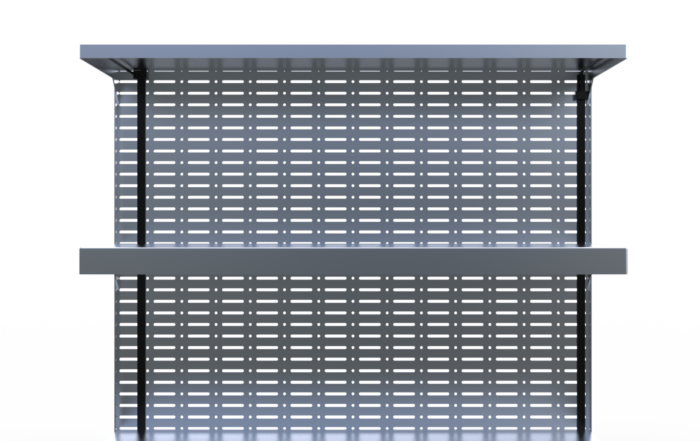Dimming is the process of reducing the intensity of a LED strip light. This is done to create a particular atmosphere or to conserve power when full illumination is not required. Previous and current dimming systems are primarily designed for incandescent light bulbs. Forward-phase and reverse-phase Dimming are two standard methods used in these setups; in both cases, the dimmer cuts or interrupts the AC line input to lower the power going into the driver. As a result, the driver’s output and the light’s intensity are proportional to the energy put into them.
When discussing Dimming in commercial LED lighting, the terms DMX, DALI, 0/1-10V, thyristor (TRIAC), WI-FI, Bluetooth, RF, and Zigbee are most commonly used. The power supply receives these signals to adjust the brightness. Typically, factors such as context (installation, wiring), purpose, cost, and scalability are considered when deciding on an input signal. Therefore, the quality of the dimming effect depends more on the output dimming method of the dimming power supply than on the input dimming method.
Standard methods of reducing a power supply’s output include a constant current reduction (CCR) and pulse width modulation (PWM) (also known as Analog Dimming).
Are all LED Strips Dimmable?
The phrase “NOT DIMMABLE” may appear in the product description of commonly used LED lights for the house, such as A-style bulbs. Some LED bulbs aren’t dimmable because their internal electrical circuitry isn’t designed to work with a wall dimmer that was intended for an incandescent bulb.
Conversely, it would be best if you didn’t plug an LED strip into a high-voltage source like a standard 120V AC wall outlet. Instead, they require a power source to convert the AC current to a more manageable DC value of 12V or 24V.
This means that to turn down the brightness of an LED strip, the wall dimmer must first “speak” to the electrical panel. If the power supply unit does not recognize the signal from the wall dimmer, the light will not dim.
But the brightness of LED strips (the strips themselves) can be dimmed in almost all cases. With the correct DC electrical signal, often PWM, the brightness of any LED strip may be adjusted.
Remember that most LED strips sold today are either constant current or voltage. This is because power requirements for dimmer operation vary.
What factors affect an LED’s luminosity?
A LED’s output is proportional to the amount of current passed through it. It is clear from the graph that adjusting the voltage also affects the current via the LED. Therefore, we hypothesize that changing the voltage across an LED can affect its output intensity. Nonetheless, we can also see that the voltage adjustment range that yields usable results without excessive current is relatively tiny. Therefore, neither the amount of light output nor the current can be predicted with any degree of accuracy.
Controlling the Brightness of LEDs
Drivers often use either pulse width modulation or constant current reduction to reduce the brightness of LEDs (also known as Analog Dimming).
“PWM” stands for “pulse width modulation” (PWM)
In PWM, the LED is rapidly cycled on and off at full power. The naked eye can perceive the rate of flipping. How bright an LED is is determined by its duty cycle or how much of each cycle the LED is ON.
Advantages:
- Provides an exact result
- The LEDs are stable in color, temperature, and efficiency, making them ideal for those uses.
- Extensive dimming range—light output can be reduced to less than 1% of its original value
- Operating the LED at its optimal forward voltage and forward current prevents color shift.
Disadvantages:
- Drivers are complicated and expensive to learn.
- Due to the rapid nature of PWM’s switching, each switching cycle’s rising and falling edges emit unwanted electromagnetic interference (EMI).
- Because the capacitance and inductance of the wires can interfere with the rapid edges of the PWM, extended wire runs can degrade the driver’s performance.
Cycle of Duty
The percentage of time that anything is “on” during its average “period” of operation is known as its “duty cycle.” The power is turned off for long stretches when the duty cycle is low. The percentage of time an appliance is on is known as its “duty cycle,” and 100% indicates constant operation. A digital signal with a duty cycle of 50% looks like a “square” wave because it is on for half of the time and off the other half. When a digital signal is on for longer than it is off, we say that its duty cycle is more than 50%. The term “duty cycle” describes the ratio of on to off times in a digital signal, and a value below 50% indicates that the signal is rarely on.
Frequency
The pulse width modulation (PWM) signal frequency is also crucial. The rate at which a PWM signal completes a period is determined by its frequency. The time between when the signal is activated and deactivated is called a period.
Decrease in Constant Current (CCR)
CCR maintains a constant current through the LED. Therefore, unlike pulse-width modulation (PWM), the LED does not cycle on and off but remains lit at all times. Accordingly, the LED’s intensity can be modified when the current is adjusted.
Advantages:
- Compatible for both near-field applications and those requiring extensive cable runs due to their remote locations
- CCR drivers, unlike PWM drivers, have a greater output voltage limit (60 V) when they are UL Class 2 drivers for dry and damp situations (24.8 V)
Disadvantages:
- LEDs don’t perform well at very low currents, so the light output can be unstable when using CCR to lower the light below 10%
- Inconsistent coloring may result from using inadequate drive currents
Dimming with DMX512
Light and effect management systems commonly employ DMX512, a digital communication network standard. Originally, DMX512 was developed to standardize the control of stage lighting dimmers, which before had been controlled via various proprietary protocols that didn’t always play nicely with one another. It rapidly became the standard method of linking control panels (such as a lighting console) to lights and other effects gear (like fog machines and intelligent lights).
Other than in the theater, DMX512 is employed for lighting in electronic billboards and large-scale performances in stadiums and arenas. In addition, it can manage any lighting, from holiday decorations to citywide illumination. The widespread use of this technology is reflected in the ease with which it can now be utilized to regulate virtually every aspect of daily life.
Adjustable Dimming utilizing the DALI System
Europe is the birthplace and primary market for the Digitally Addressable Lighting Interface (DALI). This trend is also gaining traction in the States. Digital Addressable Lighting Interface (DALI) is a standard for low-voltage communication protocols that enable the digital management of individual light fixtures.
This is a valuable tool as an information monitoring system and controls integrator. DALI lets you assign up to 64 unique names to each of your lights, with each name assigned to one of 16 distinct control zones. In addition to its flexibility in connection setup, DALI-based communication is polarity-insensitive.
0/1-10V Dimming
Dimmers that operate on a voltage range of 0-10V are the original and most basic form of electrical signaling for controlling lights. A low-voltage 0-10V DC signal is linked to each LED driver or fluorescent ballast. Dimming to the lowest level the driver can handle occurs at 0 Volts, and maximum power is achieved at 10 Volts.
LED Dimming Using TRIACs
A TRIAC, or Triode for Alternating Current, is a switch used to regulate electrical current. When utilized for lighting control, the term “TRIAC dimming” is commonly applied. Light dimmers and motor speed controllers benefit from the TRIAC’s versatility.
The usage of TRIAC circuits in the regulation of AC current is widespread. These circuits can rapidly change from high voltage to high current in response to the peaks and troughs of an alternating current waveform. These components, like a diode, are semiconductors.
Its ability to switch high voltages makes TRIAC helpful in various electrical control applications. This demonstrates its applicability for controlling commonplace lighting. However, TRIAC circuits have many more applications than only lighting. They can also switch and control AC, fans, and tiny motors.
TRIAC is a versatile protocol that can be utilized for multiple purposes in need of control.
TRIAC dimming operates at high voltage (often 230v). Therefore, connecting a TRIAC module to your house’s electrical system will produce the desired dimmer effect (100-240v AC).
Subtle Radio Frequency Dimming
With RF dimming, you can send a radio signal to the LED controller to alter the color of the lights.
Dimming with Bluetooth, Zigbee, and WiFi
Bluetooth is a standard for short-range wireless data transfer between fixed and mobile devices over the air using UHF radio waves in the ISM bands (2.402–2.48 GHz) and for creating personal area networks (PANs). Its primary functions are to displace cable connections, facilitate file exchange between adjacent mobile devices, and permit wireless headphones with portable media players and cell phones. The typical transmission mode has a power of approximately 2.5 milliwatts, resulting in a minimal range of only 10 meters (33 ft).
WiFi (/Wafa/) stands for wireless fidelity and refers to a group of protocols for wireless networks based on the IEEE 802.11 standards. These protocols allow digital devices close to exchange data via radio waves, which is why they are commonly used for local area networking of devices and Internet access. These are the most widespread data networks.
They allow many electronic devices, such as PCs, Macs, iPads, iPhones, Android phones, smart TVs, printers, and even smart speakers, to communicate with one another and access the Internet wirelessly. They are also installed in public areas to provide Internet connection for people’s mobile devices, such as cafes, hotels, libraries, and airports.
For low-power, low-bandwidth applications like home automation, data collecting from medical devices, and so on, Zigbee provides a set of high-level communication protocols based on the IEEE 802.15.4 standard. It’s ideal for use in less extensive wirelessly connected projects. Consequently, Zigbee is a low-power, low-data-rate, and close-proximity wireless ad hoc network used in the personal area.
Conclusion
Any LED strip can have its brightness adjusted. A constant voltage led strip, and a constant current led strip are two types to bear in mind. Continuous-current LED tape lighting requires a dimmable PWM-output LED strip. Constant voltage LED strips can be dimmed with either a pulse width modulation (PWM) or a constant current regulator (CCR) output signal, depending on the application. Input signals include DMX512, DALI, 0-1-10V, TRIAC, WiFi, Bluetooth, RF, and Zigbee.





